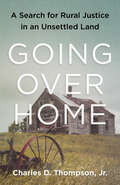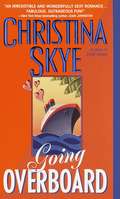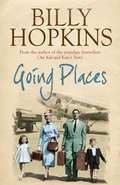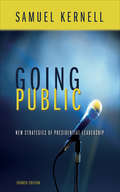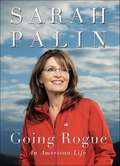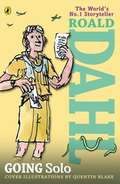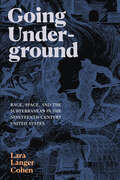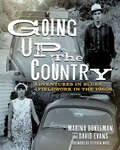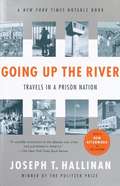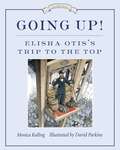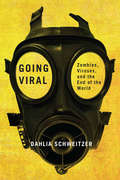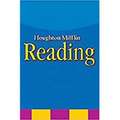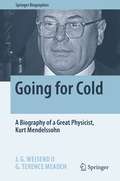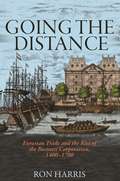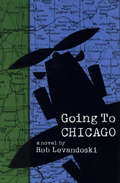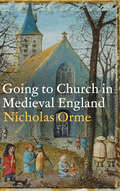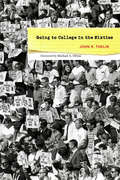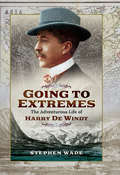- Table View
- List View
Going Over Home: A Search for Rural Justice in an Unsettled Land
by Jr., Charles Thompson"Going Over Home is a call that inspires the reader to stand shoulder to shoulder with family farmers in their daily struggle."—Willie NelsonAn intimate portrait of the joys and hardships of rural life, as one man searches for community, equality, and tradition in AppalachiaCharles D. Thompson, Jr. was born in southwestern Virginia into an extended family of small farmers. Yet as he came of age he witnessed the demise of every farm in his family. Over the course of his own life of farming, rural education, organizing, and activism, the stories of his home place have been his constant inspiration, helping him identify with the losses of others and to fight against injustices. In Going Over Home, Thompson shares revelations and reflections, from cattle auctions with his grandfather to community gardens in the coal camps of eastern Kentucky, racial disparities of white and Black landownership in the South to recent work with migrant farm workers from Latin America. In this heartfelt first-person narrative, Thompson unpacks our country&’s agricultural myths and addresses the history of racism and wealth inequality and how they have come to bear on our nation&’s rural places and their people.Booklist Editors&’ Choice &“Best Books of 2019&”
Going Overboard (SEAL and Code Name #2)
by Christina SkyeCarolina Sullivan needs a man's body bad. . . . Only the most gorgeous hunk will save fast-track photographer Carly Sullivan's job, but finding the right man isn't easy when you're on a ship in the middle of the Caribbean and the model you hired turns out to be a disaster. With her hopes sinking faster than the "Titanic, Carly spots the most beautiful man she's ever seen. Ford McKay swears he's a rancher from Wyoming, but Carly has her suspicions. Then all hell breaks loose in their island paradise and the sexy stranger is all that protects Carly from a hail of bullets. Ford McKay knows that mixing business and pleasure can be murder, and he's not about to compromise his current mission for an obstinate redhead who can't forget her camera for a nanosecond. But when Carly is wounded, the rugged Navy SEAL can't just walk away. As fate forces the two into excruciatingly close quarters, Ford finds his heart taking a tumble. Soon the straight-arrow SEAL discovers that with the right woman, going overboard can be unforgettable.
Going Places (The Hopkins Family Saga, Book 5): An endearing account of bringing up a family in the 1950s
by Billy HopkinsThe Hopkins family embark on the biggest adventure of their lives... Billy Hopkins' Going Places is a fictionalised autobiography of family life in 1950s Manchester and Kenya. Perfect for fans of Lyn Andrews and Nadine Dorries. 'Going Places is the story of a family dealing with their dreams, new challenges and heartaches, and is sure to capture the imagination of all readers' - Huddersfield Daily ExaminerIt's 1950, and when Laura and Billy Hopkins return to Manchester from their honeymoon, they're in seventh heaven despite the austerity that has been going on since World War II. But the euphoria gradually evaporates and they settle into a penny-pinching existence on Billy's teaching salary, as babies and bills appear with alarming regularity. When Billy spots an advertisement for Education Officers in Kenya, it sounds like the answer to all their prayers, despite worries about the Mau Mau rebellion and the omnipresence of dangerous creatures. After much family debate, Laura, Billy and the junior Hopkins set off to Nairobi on a BOAC Argonaut and start on the biggest adventure of their lives...What readers are saying about Going Places: 'This author has a rare gift; he can have you laughing then virtually reduce you to tears, such is his power of communication''Packed with warmth, humour anda keen understanding of life''A really lively and refreshing read'
Going Places: An endearing account of bringing up a family in the 1950s (Hopkins Family Saga #5)
by Billy HopkinsThe Hopkins family embark on the biggest adventure of their lives... Billy Hopkins' Going Places is a fictionalised autobiography of family life in 1950s Manchester and Kenya. Perfect for fans of Lyn Andrews and Nadine Dorries. 'Going Places is the story of a family dealing with their dreams, new challenges and heartaches, and is sure to capture the imagination of all readers' - Huddersfield Daily Examiner It's 1950, and when Laura and Billy Hopkins return to Manchester from their honeymoon, they're in seventh heaven despite the austerity that has been going on since World War II. But the euphoria gradually evaporates and they settle into a penny-pinching existence on Billy's teaching salary, as babies and bills appear with alarming regularity. When Billy spots an advertisement for Education Officers in Kenya, it sounds like the answer to all their prayers, despite worries about the Mau Mau rebellion and the omnipresence of dangerous creatures. After much family debate, Laura, Billy and the junior Hopkins set off to Nairobi on a BOAC Argonaut and start on the biggest adventure of their lives... What readers are saying about Going Places: 'This author has a rare gift; he can have you laughing then virtually reduce you to tears, such is his power of communication''Packed with warmth, humour and a keen understanding of life''A really lively and refreshing read'
Going Public im Deutschen Reich: Die Börseneinführungstätigkeit von Aktien im Zeitraum 1917 bis 1945
by Patrick KozikDie seit Anfang der 1980er Jahre bestehende intensive Forschung zu Börseneinführungen am deutschen Kapitalmarkt ermöglicht zuverlässige Forschungsresultate für die Zeiträume 1870 bis 1914 sowie ab dem Jahr 1948. Eine vollständige IPO-Zeitreihe für die dazwischenliegenden Jahre konnte bisher nicht präsentiert werden. Diese bestehende Forschungslücke wird nunmehr geschlossen, indem mit dem vorliegenden Buch erstmals eine vollständige Zeitreihe von Börseneinführungen für den Zeitraum 1917 bis 1945 vorgelegt wird. Zusätzlich ist es in Zusammenstellung mit bisherigen Forschungsreihen erstmalig möglich, eine lückenlose Zeitreihe von Börseneinführungen seit der Reichsgründung 1871 bis zur heutigen Börsenentwicklung zu erhalten. Darüber hinaus leistet dieser Band einen Beitrag zur Beschreibung der historischen Börsenorganisation, zur Validierung bestehender Modellansätze unter Berücksichtigung ökonomischer und politischer Schocks sowie den Nachweis positiver Emissionsrenditen für die Zwischenkriegsjahre.
Going Public: New Strategies of Presidential Leadership
by Samuel H. KernellPresidents are uniquely positioned to promote themselves and their polices directly to the public. Using sympathetic crowds as a backdrop, a president can rally public opinion to his side, along the way delivering a subtle yet unmistakable message to his intended audience in Congress. Samuel Kernell shows how “going public” remains a potent weapon in the president’s arsenal, both for advancing his own agenda and blocking initiatives from his political adversaries in Congress.In his highly anticipated fourth edition, Kernell delivers thorough analysis and detailed background on how this strategy continues to evolve given the intense polarization of Congress and the electorate as well as changes in communications technology. He considers the implications of both factors—especially in combination—on the future of presidential leadership and weighs the lessons of 9/11 on “going public” in foreign affairs.
Going Rogue: An American Life
by Sarah PalinGoing Rogue is the #1 New York Times bestselling memoir from Sarah Palin, one of America’s most beloved and controversial political figures. Now with new material, Going Rogue offers plain talk from a true American original about her life, her career, and the future of the country she loves.
Going Rouge: Sarah Palin--An American Nightmare
by Richard Kim Betsy ReedSarah Palin has many faces: hockey mom, fundamentalist Christian, sex symbol, Republican ideologue, fashion icon, "maverick" populist. But, above all, Palin has become one thing: an American obsession that just won't go away. Edited by two senior editors at 'The Nation' magazine, this sharp, smart, up-to-the-minute book examines Palin's quirky origins in Wasilla, Alaska, her spectacular rise to the effective leadership of the Republican Party, and the nightmarish prospect of her continuing to dominate the nation's political scene. With contributions by: Amy Alexander, Max Blumenthal, Juan Cole, Joe Conason, Jeanne Devon, Eve Ensler, Michelle Goldberg, Jane Hamsher, Christopher Hayes, Mark Hertsgaard, Jim Hightower, Linda Hirshman, Naomi Klein, Dahlia Lithwick, Amanda Marcotte, Shannyn Moore, John Nichols, Rick Perlstein, Tom Perrotta, Katha Pollitt, Robert Reich, Frank Rich, Hanna Rosin, Jeff Sharlet, Matt Taibbi, Michael Tomasky, Rebecca Traister, Katrina vanden Heuvel, Jessica Valenti, Patricia Williams, JoAnn Wypijewski and Gary Younge among others.
Going Solo
by Roald DahlSuperb stories, daring deeds, fantastic adventures! Going Solo is the action-packed tale of Roald Dahl's exploits as a World War II pilot. Learn all about his encounters with the enemy, his worldwide travels, the life-threatening injuries he sustained in a plane accident, and the rest of his sometimes bizarre, often unnerving, and always colorful adventures. Told with the same irresistible appeal that has made Roald Dahl one of the world's best-loved writers, Going Solo brings you directly into the action and into the mind of this fascinating man.
Going To The Source, Volume I: The Bedford Reader In American History
by Victoria Bissell Brown Timothy J. ShannonMany document readers offer lots of sources, but only Going to the Source combines a rich selection of primary sources with in-depth instructions for how to use each type of source. Mirroring the chronology of the U.S. history survey, each chapter familiarizes students with a single type of source while focusing on an intriguing historical episode such as the Cherokee Removal or the 1894 Pullman Strike. Students practice working with a diverse range of source types including photographs, diaries, oral histories, speeches, advertisements, political cartoons, and more. A capstone chapter in each volume prompts students to synthesize information on a single topic from a variety of source types. The wide range of topics and sources across 28 chapters provides students with all they need to become fully engaged with America’s history.
Going Underground: Race, Space, and the Subterranean in the Nineteenth-Century United States
by Lara Langer CohenFirst popularized by newspaper coverage of the Underground Railroad in the 1840s, the underground serves as a metaphor for subversive activity that remains central to our political vocabulary. In Going Underground, Lara Langer Cohen excavates the long history of this now familiar idea while seeking out versions of the underground that were left behind along the way. Outlining how the underground’s figurative sense first took shape through the associations of literal subterranean spaces with racialized Blackness, she examines a vibrant world of nineteenth-century US subterranean literature that includes Black radical manifestos, anarchist periodicals, sensationalist exposés of the urban underworld, manuals for sex magic, and the initiation rites of secret societies. Cohen finds that the undergrounds in this literature offer sites of political possibility that exceed the familiar framework of resistance, suggesting that nineteenth-century undergrounds can inspire new modes of world-making and world-breaking for a time when this world feels increasingly untenable.
Going Up the Country: Adventures in Blues Fieldwork in the 1960s (American Made Music Series)
by David Evans Marina BokelmanAt the height of the blues revival, Marina Bokelman and David Evans, young graduate students from California, made two trips to Louisiana and Mississippi and short trips in their home state to do fieldwork for their studies at UCLA. While there, they made recordings and interviews and took extensive field notes and photographs of blues musicians and their families. Going Up the Country: Adventures in Blues Fieldwork in the 1960s presents their experiences in vivid detail through the field notes, the photographs, and the retrospective views of these two passionate researchers. The book includes historical material as well as contemporary reflections by Bokelman and Evans on the times and the people they met during their southern journeys. Their notes and photographs take the reader into the midst of memorable encounters with many obscure but no less important musicians, as well as blues legends, including Robert Pete Williams, Mississippi Fred McDowell, Al Wilson (cofounder of Canned Heat), Babe Stovall, Reverend Ruben Lacy, and Jack Owens. This volume is not only an adventure story, but also a scholarly discussion of fieldwork in folklore and ethnomusicology. Including retrospective context and commentary, the field note chapters describe searches for musicians, recording situations, social and family dynamics of musicians, and race relations and the racial environment, as well as the practical, ethical, and logistical problems of doing fieldwork. The book features over one hundred documentary photographs that depict the field recording sessions and the activities, lives, and living conditions of the artists and their families. These photographs serve as a visual counterpart equivalent to the field notes. The remaining chapters explain the authors’ methodology, planning, and motivations, as well as their personal backgrounds prior to going into the field, their careers afterwards, and their thoughts about fieldwork and folklore research in general. In this enlightening book, Bokelman and Evans provide an exciting and honest portrayal of blues field research in the 1960s.
Going Up the River: Travels in a Prison Nation
by Joseph T. HallinanThe American prison system has grown tenfold in thirty years, while crime rates have been relatively flat: 2 million people are behind bars on any given day, more prisoners than in any other country in the world -- half a million more than in Communist China, and the largest prison expansion the world has ever known. In Going Up The River, Joseph Hallinan gets to the heart of America's biggest growth industry, a self-perpetuating prison-industrial complex that has become entrenched without public awareness, much less voter consent. He answers, in an extraordinary way, the essential question: What, in human terms, is the price we pay? He has looked for answers to that question in every corner of the "prison nation," a world far off the media grid -- the America of struggling towns and cities left behind by the information age and desperate for jobs and money. Hallinan shows why the more prisons we build, the more prisoners we create, placating everyone at the expense of the voiceless prisoners, who together make up one of the largest migrations in our nation's history.
Going Up!: Elisha Otis's Trip to the Top (Great Idea Series #4)
by Monica KullingThis is the fourth book in Tundra's Great Idea Series of biographies for young readers. The story behind the invention of the elevator is one that all young children can relate to! The previous books in the series have been well reviewed, and this new book will be equally compelling. A short, fully illustrated biography in the award-winning GREAT IDEA SERIES, about the man who invented the elevator - Elijah Otis. The man who enabled the hi-rise, and other feats of modern architecture.
Going Viral: Zombies, Viruses, and the End of the World
by Dahlia SchweitzerOutbreak narratives have proliferated for the past quarter century, and now they have reached epidemic proportions. From 28 Days Later to 24 to The Walking Dead, movies, TV shows, and books are filled with zombie viruses, bioengineered plagues, and disease-ravaged bands of survivors. Even news reports indulge in thrilling scenarios about potential global pandemics like SARS and Ebola. Why have outbreak narratives infected our public discourse, and how have they affected the way Americans view the world? In Going Viral, Dahlia Schweitzer probes outbreak narratives in film, television, and a variety of other media, putting them in conversation with rhetoric from government authorities and news organizations that have capitalized on public fears about our changing world. She identifies three distinct types of outbreak narrative, each corresponding to a specific contemporary anxiety: globalization, terrorism, and the end of civilization. Schweitzer considers how these fears, stoked by both fictional outbreak narratives and official sources, have influenced the ways Americans relate to their neighbors, perceive foreigners, and regard social institutions. Looking at everything from I Am Legend to The X Files to World War Z, this book examines how outbreak narratives both excite and horrify us, conjuring our nightmares while letting us indulge in fantasies about fighting infected Others. Going Viral thus raises provocative questions about the cost of public paranoia and the power brokers who profit from it. Supplemental Study Materials for "Going Viral": https://www.rutgersuniversitypress.org/going-viral-dahlia-schweitzer Dahlia Schweitzer- Going Viral: https://www.youtube.com/watch?v=5xF0V7WL9ow
Going West
by Jean Van LeeuwenFollows a family's emigration by prairie schooner from the East, across the plains to the West.
Going West (Houghton Mifflin Harcourt Vocabulary Readers #Leveled Reader: Level: 4, Theme: 2.3)
by Caroline VidaAn introduction to life during journeys through the American west.
Going for Cold: A Biography of a Great Physicist, Kurt Mendelssohn (Springer Biographies)
by J. G. Weisend II G. Terence MeadenThis short but revealing biography tells the story of Kurt Mendelssohn FRS, one of the founding figures in the field of cryogenics, from his beginnings in Berlin through his move to Oxford in the 1930s, and his groundbreaking work in low temperature and solid state physics. He set up the first helium liquefier in the United Kingdom, and did fundamental research that increased our understanding of superconductivity and superfluid helium.Dr. Mendelssohn's vision extended beyond his scientific and technical achievements; he saw the potential for growth of cryogenics in industry, visiting China, Japan and India to forge global collaborations, founded the leading scientific journal in the field and established a conference series which still runs to this day. He published two monographs which remain as classics in the field.This book explores the story behind the science, in particular his relationships with other key figures in the cryogenics field, most notably Nicholas Kurti at Oxford, and his work outside cryogenics, including his novel ideas on the engineering of the pyramids.
Going the Distance
by Julianna KeyesOlivia Clarke's fall from pretty, perfect, and popular happened in an instant. With her life in tatters, she impulsively accepts a teaching job in the small city of Lazhou, China. Three months in, she's ready to admit she made a huge mistake. She doesn't speak Mandarin, the teachers at her school refuse to include her in anything, and she spends her nights watching counterfeit DVDs in her twin bed. Alone. Jarek McLean is a loner. He's not looking for friends, and he's definitely not looking for love. The former army interrogator now works as a carpenter for a small construction company rebuilding a travel office in Lazhou. When he meets Olivia he knows immediately she's too wholesome to be his type, but when he discovers the pretty kindergarten teacher is hiding a secret, his inquisitive side rears its nosy head and demands answers. Olivia isn't interested in a one-sided interrogation, and makes her position clear: if Jarek wants to ask questions, he'll have to answer some, too. Jarek's never let anyone in--not into his apartment, not into his life, certainly not into his heart. But the closer he gets to Olivia, the more he falls for her, and suddenly the man who doesn't do relationships finds himself in a most unexpected one. When he reluctantly admits that this could be love, he's faced with the most terrifying question of all: What the hell does he do now?
Going the Distance: Eurasian Trade and the Rise of the Business Corporation, 1400-1700 (The Princeton Economic History of the Western World #88)
by Ron HarrisBefore the seventeenth century, trade across Eurasia was mostly conducted in short segments along the Silk Route and Indian Ocean. Business was organized in family firms, merchant networks, and state-owned enterprises, and dominated by Chinese, Indian, and Arabic traders. However, around 1600 the first two joint-stock corporations, the English and Dutch East India Companies, were established. Going the Distance tells the story of overland and maritime trade without Europeans, of European Cape Route trade without corporations, and of how new, large-scale, and impersonal organizations arose in Europe to control long-distance trade for more than three centuries.Ron Harris shows that by 1700, the scene and methods for global trade had dramatically changed: Dutch and English merchants shepherded goods directly from China and India to northwestern Europe. To understand this transformation, Harris compares the organizational forms used in four major regions: China, India, the Middle East, and Western Europe. The English and Dutch were the last to leap into Eurasian trade, and they innovated in order to compete. They raised capital from passive investors through impersonal stock markets and their joint-stock corporations deployed more capital, ships, and agents to deliver goods from their origins to consumers.Going the Distance explores the history behind a cornerstone of the modern economy, and how this organizational revolution contributed to the formation of global trade and the creation of the business corporation as a key factor in Europe’s economic rise.
Going to Chicago: A Novel
by Rob LevandoskiThere's real despair in Bennett's Corners, Ohio. It's 1934, and The Great Depression is dragging on. That's not to say young people don't have their big burning ambitions, their uncontrollable urges. They do. Will Randall's dream is to go to the Chicago World's Fair, to see the technological wonders of the modern age and to prepare himself for the glorious future sure to erupt once FDR gets a handle on things. Ace Gilbert had a different dream. He wants to find a "willing city girl". So, on a scorching August day these two very-best-of-friends set out for Chicago in Ace's old Model T, which has been transformed with wings and a propeller to look like the Spad SXIII his father flew in The Great War. This is going to be the best week of their lives, even if Will's little brother--and his ear-ache--have to come along. Driving across the Indiana cornfields, they're kidnapped by a pair of penny candy criminals, Gus Gillis and Gladys Batholomew, and thus begins an adventure none of them had bargained for. At times, Aces's narrative is wickedly funny, at other times tearful. And sometimes, his bewilderment comes to full boil. Going to Chicago is much more than a period romp across the American heartland. It's a journey into friendship--a friendship bigger than death.
Going to Church in Medieval England
by Nicholas OrmeAn engaging, richly illustrated account of parish churches and churchgoers in England, from the Anglo-Saxons to the mid-sixteenth century Parish churches were at the heart of English religious and social life in the Middle Ages and the sixteenth century. In this comprehensive study, Nicholas Orme shows how they came into existence, who staffed them, and how their buildings were used. He explains who went to church, who did not attend, how people behaved there, and how they—not merely the clergy—affected how worship was staged. The book provides an accessible account of what happened in the daily and weekly services, and how churches marked the seasons of Christmas, Lent, Easter, and summer. It describes how they celebrated the great events of life: birth, coming of age, and marriage, and gave comfort in sickness and death. A final chapter covers the English Reformation in the sixteenth century and shows how, alongside its changes, much that went on in parish churches remained as before.
Going to Church in the First Century
by Robert BanksNot what you expect. This look inside a first-century meeting will make you rethink what (or who?) the church really is. "From a religious point of view the whole meeting left a lot to be desired. What had happened contained scarcely anything religious at all. They didn't even have a priest, let alone all the rituals that you expect. This wasn't quite what I had bargained for. Neither decently ritualistic nor exotically mysterious. All very simple and matter of fact."
Going to College in the Sixties
by John R. ThelinThe 1960s was the most transformative decade in the history of American higher education—but not for the reasons you might think.Picture going to college in the sixties: the protests and marches, the teach-ins and sit-ins, the drugs, sex, and rock 'n' roll—hip, electric, psychedelic. Not so fast, says bestselling historian John R. Thelin. Even at radicalized campuses, volatile student demonstrations coexisted with the "business as usual" of a flagship state university: athletics, fraternities and sororities, and student government.In Going to College in the Sixties, Thelin reinterprets the campus world shaped during one of the most dramatic decades in American history. Reconstructing all phases of the college experience, Thelin explores how students competed for admission, paid for college in an era before Pell Grants, dealt with crowded classes and dormitories, voiced concerns about the curriculum, grappled with new tensions in big-time college sports, and overcame discrimination. Thelin augments his anecdotal experience with a survey of landmark state and federal policies and programs shaping higher education, a chronological look at media coverage of college campuses over the course of the decade, and an account of institutional changes in terms of curricula and administration.Combining student memoirs, campus publications, oral histories, and newsreels, along with archival sources and institutional records, the book goes beyond facile stereotypes about going to school in the sixties. Grounded in social and political history, with a scope that will appeal both to a new generation of scholars and to alumni of the era, this engaging book allows readers to consider "going to college" in both the past and the present.
Going to Extremes: The Adventurous Life of Harry de Windt
by Stephen WadeHarry de Windt (1856–1933) was a man who, by any standards, was a personality, a marked presence in the world of Victorian and Edwardian literature and social life. He was a member of the literary circle around Oscar Wilde and his friend and lover, Bosie (Lord Alfred Douglas); he was active in the world of the turf; and he travelled he took on dangerous journeys with relish, crossing vast tracts of the British and Russian empires for the sheer thrill of it. This book traces his life and adventures, at home and abroad, and also gives an account of his early work on military service in Sarawak, Malaysia, his expert knowledge of the Russian prison system, and his later Great War role running a POW camp. Many of his books reflect epic journeys against the odds: From Paris to New York by Land, Savage Europe, Siberia As It Is and others. His autobiographical work, My Restless Life, perhaps sums up his nature.Interesting facts: * Harry de Windt was brother to the Ranee of Sarawak and fought against rebels there in his early career * He visited the penal colony on the Russian island of Sakhalin close to the same time that Anton Chekhov went there * He appeared as a witness in the trial for libel of Lord Alfred Douglas, as he blamed Winston Churchill for the heavy losses in the Battle of Jutland * On his travels he met a host of interesting people from murderers to statesmen
